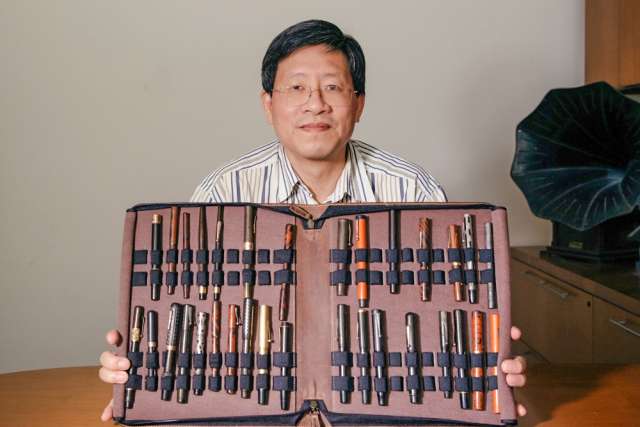IF OTTO O. YANG, MD, IS WEARING A BUTTON-DOWN SHIRT, it’s a good bet that there will be an antique fountain pen clipped in his breast pocket. If so, it likely will be one of the more than 300 that he has collected and restored over the course of 30 years. For a researcher and clinician who examines the world at the cellular level, a love for such old-fashioned writing implements may seem incongruous. But with its form, function and history, the vintage fountain pen reflects a bygone era to which Dr. Yang has been drawn since childhood.
“Ever since I was a kid, I’ve been intrigued by things that are very old,” he says. “I started out in collecting just like a lot of kids do, with stamps and coins and things like that. As I got older, my interest in antiques just grew from there.”
It is an interest that transports him ages away from his day job as a professor of medicine and associate chief of the Division of Infectious Diseases. Over the past two years of the COVID-19 pandemic, the foundation that he laid with his more than two decades of research at UCLA on immune therapies and vaccines against HIV, as well as other viral infections and diseases, has made him a go-to expert on the new coronavirus; since the pandemic was first declared in March 2020, his name has appeared in news stories more than 5,000 times.
What would become his passion for antique pens began during his medical training when, as a resident at Bellevue Hospital in New York City in 1991, Dr. Yang was browsing a stall in one of the area’s large flea markets and an unusual object caught his eye. Shaped like a small barrel, with a removable cap and a curving triangular tip, it was an antique fountain pen. He purchased it, and the beginning of his remarkable collection was born.
“Antique fountain pens first captured my attention because of the variety of interesting designs, but then I came to appreciate the function as well,” he says. “Early pens, even the fairly inexpensive ones, far outperform many modern fountain pens, which are so expensive and have become status symbols now.”
As his interest in antique pens grew, Dr. Yang narrowed his focus to pens produced from their earliest years to the start of the 20th century. This was an era during which no fewer than 50 different companies were producing pens, almost all of them American, including still-familiar names like Waterman and Parker, but also now-forgotten ones like Conklin. Dr. Yang’s pens range from simple hard-rubber cylinders designed to carry as much ink as possible to elegant Art Nouveau gems encased in twining designs of chased silver.
These are from very early in the 1900s, when there was a brief period during which pens were highly decorated, almost like jewelry,” he says, showing off a few examples. “You would invest in a fountain pen, and it would be like a wristwatch, something you would keep for years and years. A company in New York brought in craftsmen from Europe who briefly produced ornate hand-made silver- and gold-covered pens for wealthy buyers, but within a few years decorative metal overlays were mass produced. Starting in the ’20s, when plastics became available, the emphasis switched more to colorful designs, and while I do have a few of those, to me they’re not as interesting.”
Among Dr. Yang’s finest finds is the so-called Parker “Snake” pen, a slim, tapered shape wrapped with a green-eyed snake made of silver. Another favorite is the Waterman “Tree Trunk” pen. Also wrapped in silver, the design is reminiscent of the whorls and knots of a tree. “No one knows why it exists,” Dr. Yang says, with a laugh. “But it’s an iconic pen — there were only a couple dozen known to exist — and it’s a mystery what the design is supposed to be and who commissioned it.”
Although the fountain pen is a niche writing implement today, its invention at the end of the 19th century was nothing short of revolutionary. For the first time in history, writers were liberated from the tyranny of the stationary inkwell. Efforts to invent a pen with a portable reservoir of ink trace back to the ancient Egyptians. Leonardo Da Vinci left behind drawings of a fountain pen prototype. A string of inventors tried their hand throughout the 18th and 19th centuries, but it wasn’t until Lewis Waterman came along with a patented design, in 1884, that resolved some key issues that had hindered development, such as equalizing the pressure inside the closed reservoir while allowing the ink to flow out, that the modern fountain pen was born.
Not just an object of function and form, the fountain pen also has been the subject of some academic exploration. In 2017, a graduate student at Auburn University, Charles Busby, wrote his master’s thesis — by hand, using several of the elegant writing instruments — entitled, “The Forgotten Fountain Pen: The Historical Significance of the Fountain Pen in Twentieth-Century American Society.” “It was Waterman’s patent that made production of the fountain pen possible,” says Busby, who today is an archivist at the Alabama Department of Archives and History. “Once Waterman PHOTO: JESSICA PONS solved the problems of ink and air flow, fountain pens become extremely popular because they were both easy to use and easy to manufacture.”
While popular, fountains pens were far from inexpensive. The better pens sold for $10, which in the early 1900s was equal to a week’s salary. The convenience of ballpoint pens, which went into wide production in the mid1940s, was a death knell for fountain pens. However, their demise was only temporary. A resurgence of interest began in the 1980s, and Busby says he’s not surprised. “Fountain pens satisfy a desire for authenticity, for distinction,” he says. “Using a fountain pen is the exact opposite of flickering screens and digital communication like Facebook, which is one of the reasons they have an enduring value and an enduring legacy, even today.”
After three decades of collecting, studying, repairing and refurbishing antique fountain pens, Dr. Yang is firmly entrenched in that legacy. With his eclectic collection mostly complete, he now finds pleasure in helping and guiding new enthusiasts. “I’ve been collecting for a long time, so there are very few examples that interest me that I don’t already have,” he says. “In terms of collecting, it’s more that I’m looking to be surprised. The joy for me now is when I see or learn something new. And it’s also interacting with new collectors, sharing knowledge and enjoying and sharing in their enthusiasm.”

